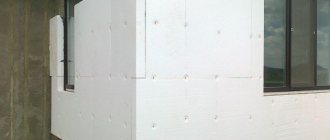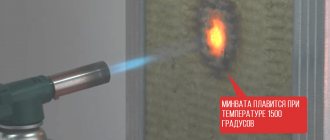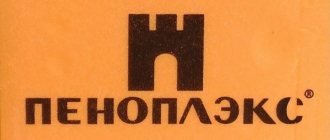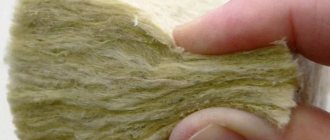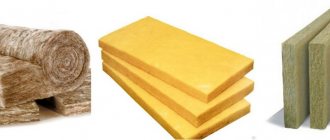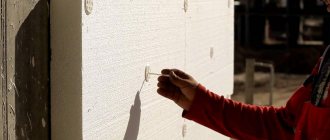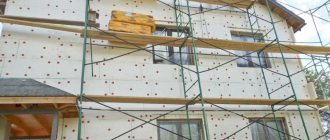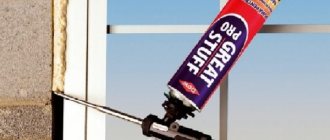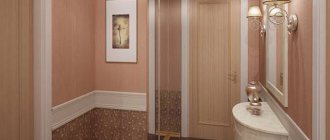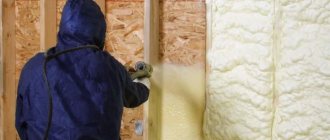Thermal insulation measures are becoming an integral part of construction work. A huge selection of insulating materials and simple installation technology contribute to this. Comfort is created not where they spend a lot of money on heating, but where they retain heat. One of the popular options is mineral wool insulation. The heat insulator has many advantages, and working with it is simple.
Mineral wool - concept and features
The word “mineral” indicates the origin of the heat insulator. It is made from natural ingredients: rocks, limestone, clay, basalt, dolomite. When they melt, fibrous material is formed, from which mineral insulation is made. There is only air between the fibers, due to which the wool has excellent heat and sound insulation characteristics.
Mineral wool has a trump card that other insulation materials cannot boast of: it is not afraid of deformation loads.
Insulating mineral wool is produced in the form of slabs and rolls. The peculiarity of slabs (mats) is that they are more rigid/dense and can keep their original shape. Rolls are suitable for floors, attic floors (they are horizontal) and for unloaded structures. Peculiarities:
- Strength from 0.08 to 0.06 kg/cm2. The difference depends on the type of heat insulator.
- Thermal conductivity coefficient is from 0.036 to 0.060 W/(m*K), depending on the density.
- Moisture absorption 6–30% when completely immersed in water.
- The density of mineral wool for wall insulation is from 35 to 100 kg/m3.
- Vapor permeability from 0.21 to 0.41 mg/(mchPa).
- Fire resistance is high. The material can withstand temperatures of 1000 degrees.
- Sound insulation from 0.7 to 0.9 Rw (dB).
- Thermal insulation material will last from 50 to 70 years.
general information
Mineral wool is a fibrous material obtained from metal slag or molten rock.
Mineral wool has been used for effective wall insulation for decades, but now manufacturers produce much better products than before. The harmfulness of the material to the environment and the human body has been reduced, and its thermal insulation properties have been increased.
There are several subtypes of mineral wool for wall insulation, and we will now consider them.
Varieties of mineral wool
Mineral wool is the general name for a thermal insulator, indicating its origin. But, there are several types of products that differ from each other. They are:
- Glass wool. It has been used for a long time, but with the advent of new analogues, it is losing relevance. When working, it is important to protect the respiratory tract, mucous membranes and skin, since the insulation releases small particles of glass.
- Slag-like. Made from blast furnace slag. Rarely used in private housing construction. Suitable for non-residential premises, warehouses or temporary structures. Capable of oxidizing metal and strongly absorbing moisture.
- Stone wool. It is made by melting rocks (gabbro-basalt). Suitable for both insulation of facades and thermal insulation inside.
- Basalt wool. They prefer to insulate a house with mineral wool using this particular heat insulator. In all respects, basalt materials are better and of higher quality, they have a longer service life, and are easy to work with.
If you need to insulate a frame house using mineral wool, then the scheme involves the use of basalt wool. It is dense, does not shrink and does not burn, which is important for safety reasons.
Types of mineral wool
This term means not one material, but five:
- Glass wool. This is the most popular insulating material. When working with such material, you need to wear a special protective suit, goggles and a respirator.
- Slag-like. Numerous disadvantages of this substance do not make it possible to use it as thermal insulation. The material easily absorbs moisture and interacts with metal surfaces, oxidizing them.
- Stone wool. According to its characteristic features, this material resembles slag wool. This type of insulation does not scratch, so it is easier to work with.
- Basalt wool. It does not contain blast furnace slag or various additives. The material is practically not subject to combustion. This variety is most often used as thermal insulation.
Recently, it is often practiced to insulate walls with ecowool. This material is environmentally friendly and has a high degree of sound insulation. It’s up to you to decide which mineral wool is best to use for insulation.
Pros and cons of mineral wool
Mineral wool is the most popular and effective thermal insulator for wall insulation. There are many reasons for this:
- Thermal and sound insulation is good, mineral wool is one of the best in this area, can be compared with foam plastic and polyurethane foam.
- During operation, the mineral board for wall insulation will not begin to deform.
- Environmental friendliness. Does not emit toxic substances and does not interfere with allergies.
- Light weight. The material does not heavily load the structure and foundation as a whole.
- Easy to install. Even a beginner can make thermal insulation inside and outside with his own hands.
- Not afraid of sudden temperature changes.
- Thanks to vapor permeability, the walls will breathe. This is especially important if you need to insulate frame or wooden walls with mineral wool so that the wood can also breathe.
As for the disadvantages, we can note its strong water absorption. When wet, it loses its properties. But this does not apply to all types of mineral insulation. These indicators are lower for basalt wool. But, after drying, the heat insulator is restored. Another disadvantage is that cotton wool fibers scatter in different directions during operation and can cause harm. Therefore, the technology of wall insulation requires personal protective equipment: glasses, a respirator, gloves, clothing covering the skin.
Advantages of insulated walls
High-quality thermal insulation work allows you to achieve high indoor comfort, achieve the desired level of heat and maintain it for a long time. During the winter months, mineral wool prevents cold air from cooling the walls too much.
In addition, by increasing the thickness of the walls and thanks to its thermal conductivity characteristics, it is possible to eventually achieve a shift of the so-called dew point beyond the limits of the wall material (for example, into the same insulation). Thus, the service life of the structure can be significantly increased.
In summer, thermal insulation functions differently: it prevents the walls of the house from overheating, creating conditions for a constant temperature. Due to this, the house becomes cooler (compared to the street).
The facade of the house insulated with mineral wool and a well-thought-out ventilation system will help to avoid dampness, the development of mold and fungi, the presence of which has a detrimental effect on human health.
Installation of a new heating system, high-quality windows with double-glazed windows in several chambers, as well as doors will complement the list of necessary steps to create optimal housing.
In what cases is it better to use mineral wool?
It is difficult to answer the question of what is better to insulate a house, mineral wool or polystyrene foam. After all, various factors are taken into account. For example, polystyrene foam is not suitable for wooden houses, since it is not vapor permeable. But, protection from moisture is better. On the other hand, it burns, is not environmentally friendly and is spoiled by rodents. Although, mineral wool weighs more and is more expensive. Such nuances are taken into account and the best option is selected.
Insulation of the walls of a wooden house from the inside is done with cotton wool, since polystyrene foam releases harmful substances when heated. In conditions of elevated temperatures, cotton wool is also better suited (sauna, bathhouse, wall near the fireplace or near the stove). The same applies to insulation in a house where an allergy sufferer lives. It is also better to insulate the roof and ceilings with cotton wool.
List of tools and materials
To insulate a house with mineral wool, it is enough to buy the necessary arsenal of tools, consumables, study the instructions and bring everything to life. During the work you will need:
- Scaffolding. Working with a ladder is inconvenient. It is better to rent forests.
- Construction and water level. Ideal if you have a laser level.
- Hammer with extension.
- Wood saw.
- Narrow and wide spatula, grater.
- Container for mixing the solution.
- Construction mixer.
- Hammer.
- Roulette.
Installation of mineral wool requires the following consumables:
- Deep penetration primer.
- Reinforcing fabric mesh and corners.
- Adhesive composition and dowels for mounting mineral wool on the wall.
- Decorative plaster and paint.
- Cornices.
Everything is ready to insulate the outside with mineral wool.
How to properly insulate a house with mineral wool with your own hands step by step
We will consider the classic option: insulating the outside of a private house with mineral wool using plaster. The method is called wet. The work is carried out at a certain temperature range from +5 to 30 degrees. But, there is an option to insulate the walls with mineral wool from the outside in frost (up to -10) using anti-frost additives.
The whole process is divided into several stages:
- Preparatory work.
- Padding.
- Fastening mineral wool to the wall.
- Reinforcement with dowels.
- Sticking metal corners to façade corners and slopes.
- Creation of a reinforcing layer.
- Priming and creating the finishing layer.
The façade structure, or pie as it is called, will consist of several layers. Namely: wall, adhesive solution, mineral wool, umbrella dowels, second layer of glue, reinforced mesh, glue, finishing.
Preparing the walls
The technology of insulating walls with mineral wool requires careful preparation of the surface. The main requirement is evenness. A deviation of 15 mm per floor is allowed. Cracks in the walls are sealed so that there are no cold bridges. When insulating a brick wall from the outside with mineral wool, it is necessary to remove excess mortar from the seams, if any remains. The same applies to interfering protruding elements.
If the wall is too old, it can be primed and plastered using reinforcing mesh. Further work is carried out a week later. During this period, the plaster will completely dry.
Installation stages
Insulation of walls from the outside with mineral wool under plaster begins with fixing the starting strip (profile) at the bottom of the walls. The width of the plank is identical to the thickness of the wool, since the slabs will be inserted and rested on the profile. To align the plinth level, you need a level, ideally a laser one.
Then you can install the first row of slabs. First they are fixed with glue. It is applied to the back side of the slabs either in spots or in a continuous layer (toothed base method). The second option is used for perfectly smooth walls. The thickness of the adhesive layer is 3 mm. The plate is installed in its place and pressed with hands. It levels out. Then the second mineral wool slab is glued. It must be remembered that the second row is done with a dressing of 10 cm, so that the seams are not located opposite each other, but overlap one another. For convenient joining, the mineral wool can be trimmed.
The next stage is the installation of anchors or dowels. But, it is important to leave the wall until the glue dries for 2 days. Dowels are inserted into holes drilled with a hammer drill. Then a core with an umbrella is hammered into them to hold the slab. For 1 m2 you will need 5 dowels.
Now all that remains is to make the reinforcing layer. To do this, a layer of glue is applied, a reinforcing mesh is embedded in it and more glue is applied. The mesh should be in the thickness of the glue and not come into contact with the mini-slab. The mesh is mounted without sagging, with an overlap of 10 cm. The mesh is rolled across the width of the door and window opening.
At this point, the insulation of the outside walls of a wooden house with mineral wool is almost complete. All that remains is to wait for the glue to dry and start finishing the exterior.
Video description
In simple words, the calculation of insulation thickness is described in the following video:
Frame materials
Both types of materials are used for lathing: galvanized metal profile and wooden beams.
The use of metal profiles is provided for in all factory-made hinged facade systems. Dimensional stability, clear geometry of unified forms - all this is ideal for industrial replication and development of installation flow sheets. But they have one drawback - the metal serves as a “bridge” of cold and reduces the thermal insulation properties of the curtain wall. Even the standard for thermal protection of buildings has an unambiguous recommendation for minimizing metallic inclusions in insulation. And if you can’t do without fasteners, then the sheathing can be made of wood.
Wood is more “capricious” and heterogeneous in its structure. Lumber may “lead” during storage, which leads to a change in shape. There are knots, resin pockets, cracks and almost a dozen other defects specified at the standard level. But despite this, timber sheathing is often used for cladding wooden houses. Although this requires certain selection and pre-processing of the material.
Wooden beams are often used as a frame for insulation. Source pro-uteplenie.ru
The principle of insulation under siding (ventilated facade)
Knowing the fact that mineral wool is vulnerable to moisture, it needs to be used. Namely, to ensure the removal of this moisture from the material. To do this, it is better to resort to the technology of creating a ventilated facade. This is the insulation of a wooden house from the outside with mineral wool under the siding. Frame technology is used here, which creates a ventilation gap where there is air. The cotton wool will dry out and restore its functions. This is the best option if you need to insulate a wooden house with mineral wool.
The process is as follows:
- The walls are being cleaned.
- The sheathing is installed. It can be made of wood or metal. The distance between the planks is equal to the width of the mineral wool. You can make it 0.5 cm smaller to fit the cotton tightly.
- A vapor barrier film is fixed with an overlap of 10 cm.
- The insulation is placed in its place. The boards must fit tightly.
- Creating a counter-lattice. This will create the required gap. In addition, siding will be attached to it.
- All that remains is to attach the waterproofing and install the siding.
The insulation of the walls outside with mineral wool under the siding has been completed.
What you need to know about insulating a wooden house
Wood is different from all other natural and artificial building materials. In its natural state, it is a network of capillaries through which the “organs” of a living organism are nourished. After the tree is cut down, sanded, processed and during the shrinkage of the finished structure, the wood is dried to a moisture content level of 16-20%.
Drying is never complete. Moreover, it is reversible - when there is excess humidity, water vapor is absorbed from the air. In addition, wood is a “breathable” material, especially along the grain. This means that air is exchanged between the room and the street at the level of gas diffusion through the wall structure. This ability of a wooden house to self-regulate the microclimate is most valued.
